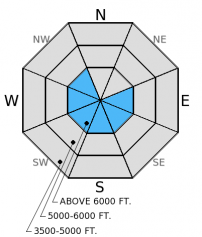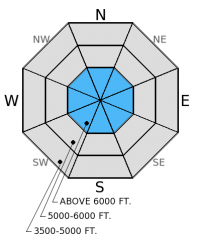| Saturday | Saturday Night | Sunday | |
|---|---|---|---|
| Cloud Cover: | Mostly sunny | Clear and cold | Partly cloudy and slightly warmer |
| Temperatures: | 21-34 deg. F. | -7-10 deg. F. | 26-36 deg. F. |
| Wind Direction: | NE | N/NE | S/SW |
| Wind Speed: | 9-11 gusts 20-22 | 2-3 | 5-6 |
| Snowfall: | 0 in. | 0 in. | 0 in. |
| Snow Line: |
Whitefish Range
Swan Range
Flathead Range and Glacier National Park
How to read the forecast
The hazard above 6000 feet is MODERATE on slopes steeper than 35º and LOW on all other terrain. Recently formed wind slabs and in some areas, surface hoar formed over a crust in late-January remain reactive. Though generally safe conditions exist in most terrain, it is important to assess slopes for weak and reactive layers before skiing or riding on them.

2. Moderate
?
Above 6500 ft.
1. Low
?
5000-6500 ft.
1. Low
?
3500-5000 ft.
- 1. Low
- 2. Moderate
- 3. Considerable
- 4. High
- 5. Extreme
-
Type ?
-
Aspect/Elevation ?

-
Likelihood ?CertainVery LikelyLikelyPossible
 Unlikely
Unlikely -
Size ?HistoricVery LargeLargeSmall

In the western portion of the advisory area wind slabs may be thin or non-existent, but as you near the Continental Divide they become thicker and more dangerous. These slabs are easy to identify and avoid (photo), and are fairly small relative to the size of the slope. In most locations they seem confined to just below ridgelines and cross loaded terrain features (photo). Look for rounded pillows of wind drifted snow and where present, avoid convex roll-overs or terrain where getting knocked off of your feet or machine could have high consequence.
-
Type ?
-
Aspect/Elevation ?

-
Likelihood ?CertainVery LikelyLikelyPossible
 Unlikely
Unlikely -
Size ?HistoricVery LargeLargeSmall

The late January surface hoar (or facet) and crust layer 1.5-2.5 feet from the surface still exists in our advisory area. Stability test results are variable. In some locations it propagates a fracture and others it does not even fracture, and the distibution is spotty. Snowpack tests show that this layer would be difficult to trigger, but the potential for propagation exists. We haven't observed or received reports of avalanche activity involving this layer in over two weeks. This makes it unlikely, but not impossible. It's still important to dig into the snowpack and identify if the layer is present or not by performing a stability test like the extended column test. If it is reactive keep the slope angle less than 35 degrees and avoid steep, rocky terrain where you are more likely to trigger this layer. The cumulative load of new snow plus a human trigger in the eastern edge of the advisory area could reawaken this layer.
The new snow over the previous week fell on a crust from mid-February. Loose snow sluffs are possible on slopes greater than 35 degrees, but should not be very large. However, in high consequence terrain these sluffs can be dangerous.
The eastern portion of the advisory area was favored in recent snow fall totals. In an attempt to be where the "action" is, we traveled to the Skyland area in the Flathead Range yesterday. We found 6-10 inches of low density, cohesion less snow in sheltered areas on top of the mid-February crust. Along the ridgeline and near cross loaded terrain features where the wind was drifting the recent snow (photo, photo2), we found slabs that ranged from 8 inches to nearly 2 feet thick. Due to the fact that these slabs formed on a slick surface (Mid-February crust) with weak snow above they are still reactive in stability tests (video). Again, illustrating the "spotty" distribution of the persistent slab problem, we found late-January surface hoar that was reactive in stability tests less than a week ago (video) and yesterday, in a nearby area, we did not.
A cold, arctic air mass remains parked over the region. Yesterday we saw continued cold temperatures with moderate north/northeast winds. No new snow fell in the area over the past 24 hours. As of 4:00 am, mountain temperatures range from -5º-9ºF and winds are blowing out of the north at 5-15 mph gusting to 25 mph. Today will be mostly sunny, temperatures should reach the mid-20s with northeast winds blowing 5-15 mph.
| 0600 temperature: | -5-9 deg. F. |
| Max. temperature in the last 24 hours: | 13-22 deg. F. |
| Average wind direction during the last 24 hours: | NE |
| Average wind speed during the last 24 hours: | 5-15 mph |
| Maximum wind gust in the last 24 hours: | 10-25 mph |
| New snowfall in the last 24 hours: | 0.00 inches |
| Total snow depth: | 65-91 inches |
This advisory applies only to backcountry areas outside established ski area boundaries. This advisory describes general avalanche conditions and local variations always occur. This advisory expires at midnight on the posted day unless otherwise noted. The information in this advisory is provided by the USDA Forest Service who is solely responsible for its content.

































